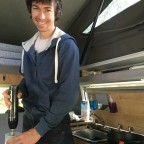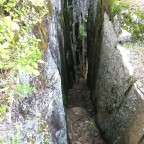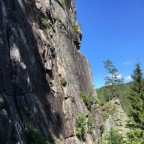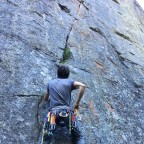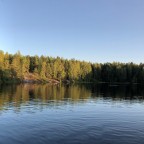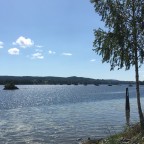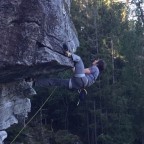Hauktjern
22.07.2019-23.07.2019 - On Sunday we arrive at the climbing area Hauktjern. The parking area is located next to a beautiful lake surrounded by forest. Since it does not really get dark even after 22:00, we have enough time to find a nice spot and to explore the area.
We start our first real day of our vacation with a leisurely breakfast. Sigi makes pancakes (lactose free of course) and I start my travel diary in the meantime. It has been drizzling at night and therefore we do not set off for the climbing area until early afternoon. Since this is a local recreation area of Oslo, the main paths are wide and well maintained. Only the last few hundred meters we have to walk on small forest trails surrounded by blueberries. The foremost sectors are easy to access. The descent to the backmost sectors is a little bit more difficult because both options are steep and slippery. The best way is through a narrow crevasse in the ground. We climb in the backmost sectors since they seem to be varied and provide a good mixture of grades. In our opinion the grading is rather hard. Furthermore, some of the topos in the climbing guidebook Climb Norway are quite confusing. On the first day Sigi climbs a route, which is supposed to be bolted, but after an overhang it turns into a trad route without any protection. The next day he tries a 6a trad route. However, the moves are far too hard for this grade. Therefore, we ask a Norwegian couple if we can have a look at their local climbing guide. It turns out that the first pitch of this trad route is 7b and the second one is 6a. In addition, we find out that the grades of some routes do not match. In the climbing guidebook Climb Norway the Norwegian grades have been converted to the French grades, but apparently not consistently and with a special conversion table. Most of the routes between 6a and 6c are affected.
At temperatures above 25 degrees Celsius we prefer climbing in the shade and finish the climbing days with a swim in the lake. Some of the locals do not go climbing until after 18:00 and stay until after 22:00 because there is still enough light.
Overnight stay: N 59.889325, E 10.863039
Hammer‘n
24.07.2019 - On Wednesday we continue to Hammer’n. After a short drive of about 30 minutes we enjoy the beautiful view over a river. The climbing area is small but nice and offers varied climbs on rough rock. We meet a Finnish and a Spanish couple with whom we chat about their recent experiences in Norway.
Overnight stay: N 59.9897, E 11.2086
Lessons learned
- A generous and leisurely breakfast is a good start for your holiday.
- The daily routine should be adapted to the temperatures. You can set off for climbing in the late afternoon and continue until at least 21:00.
- In the climbing guidebook Climb Norway routes between 6a and 6c are often graded differently than in the local climbing guidebooks.
- Check out every route BEFORE climbing because a bolted sport climbing route can turn into a trad climbing route.
- Many trad routes are completely clean and there is no fixed gear at the top. This means that a second climber has to follow and collect the gear. In some areas it is possible to lower on your own gear and to collect it at the top when leaving the climbing area.
- The climber should advise his belayer to wear long clothes and generously spray him with mosquito repellent.
- Advice from Norwegians: Do not go to the Lofoten until August since there are too many mosquitoes and tourists until the end of July.





